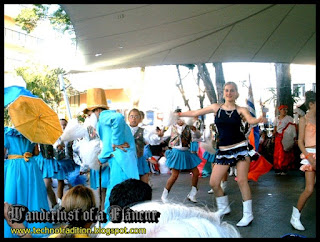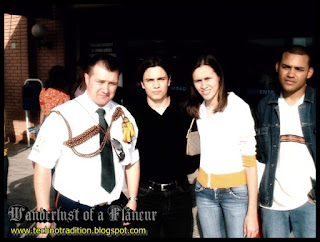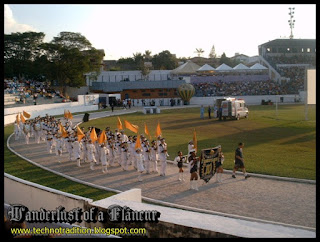First of all, let's define what it is all about:
"A marching band is a group in which instrumental musicians perform for entertainment, and prepare for a competition. Instrumentation typically includes brass, woodwinds, and percussion instruments. Most marching bands wear some kind of uniform (often of a military style) that includes the school or organization's name or symbol." Wikpedia
WAMSB (World Association of Marching Show Bands) is an international organization of marching show bands holding many competitions throughout the world. It's World Championships are held annually in the summer in a different country and this year of 2005 it would be held in Taubaté, São Paulo, Brazil, which is known in this marching-band area by its band named FAMUTA
At that time, I was a History student at UNITAU and as I had just moved from São Paulo City (from UNINOVE) I needed to do some extra-work to register hours of activity in my field. I asked my teacher Cyro de Barros Rezende Filho (an excellent, intelligent and polemical professor) if I could cover some presentations of those marching bands and extract some information and pieces of History from them and report it for him so I could have those hours of activity registered, he said yes and now here I am posting my work.
The Mundial de Bandas e Fanfarras (the name of the event in Portuguese) was set to last from the 7th to the 14th of August, 2005, and would gather bands from many parts of Brazil and many countries of the world. I covered some of the presentations with some friends of the university and I even made an interview in English with a band from England (I didn't know how I managed to do it years ago).
Report on August 11th, 2005
Program: 3pm: Presentation of Banda Municipal Dolores - Uruguay
5pm: End of presentation and interview with members
Location: Praça Dom Epaminondas
About Banda Municipal Dolores: The marching band, from Soriano has 70 members, including adults and children, divided into two basic functions: the instrumentalists (trumpet, trombone, saxophone, etc.) and the dancers. They often use the traditional dress of brass bands in light blue colour, representing one of the colours of the Uruguayan flag.
About The Presentation: A variety of music styles was presented, the first song represented a rural style, called Pericón. Soon after they played a carnival dance in a more Uruguayan style than the traditional Brazilian carnival, the band went on with a tango, traditional in Argentina but also in Uruguay. Finally, and the most interesting repertoire, was the music of the black people, candomble. We expected some resemblance to the Brazilian Candomblé, but this black music was popularized differently in Uruguay, getting more rhythm than the usual drumming from here. The band did not have space to perform their rehearsed performances, because they had the space of a gazebo but, as a result, the dancers were in evidence, dancing to the lively rhythms of the repertoire and making every one of the public to move to the melodies that resembled the Brazilian samba, also in the form of dance and dressing of the girls.
The conductor who gave me the interview (Sorry, I really didn't get her name at that time). The picture has: Adriano and Serginho on the back and me, the conductor and Aline.
We with the musicians and dancers
Me, Aline, the blond dancer, Adriano, Serginho and the latin dancer
Report on August 11th, 2005
Program: 3pm: Presentation of Church Lads' and Church Girls' Brigade from Darwen, St James Church (England)
4pm: Presentation of Banda Marcial Morada do Vale
5pm: End of presentation and interview with members
Location: Shopping Taubaté
About St James' Marching Band: It has 29 members. The uniforms are the traditional style, showing a clear military image to the band what reflects on their behaviour and organization in their presentations. Their difference is in the use of the marimba, an instrument not found in any other bands in the competition.
About the Presentation: The setlist had traditional songs and some versions of famous songs. They had space to show their performance throughout the mall parking lot and they made it very accurately. Especially their drum major, a very gifted boy.
Short interview with the conductor of the band
What are the musical influences of the band?
Conductor: The marimbas are influenced by Opera, Robbie Williams and Les Miserables. The trumpets have the influence of traditional military music.
Conductor: The marimbas are influenced by Opera, Robbie Williams and Les Miserables. The trumpets have the influence of traditional military music.
How do you like Taubaté? What have you found curious about it here?
Conductor: We loved Ubatuba and I particularly found interesting the way Brazilian girls are attracted to the British boys.
Conductor: We loved Ubatuba and I particularly found interesting the way Brazilian girls are attracted to the British boys.
Is this the first time you com to Brazil?
Conductor: It's the first time in Brazil, we have already been to countries in Europe as Germany, Holland and Belgium.
Conductor: It's the first time in Brazil, we have already been to countries in Europe as Germany, Holland and Belgium.
How old is the band?
Conductor: Since February 25, 1925, it means 80 years.
-------------------------------------------------- --------------------------------------------
About Banda Marcial Morada do Vale: They are from Gravataí, Rio Grande do Sul. The band is composed of 53 members and plays a popular repertoire, but also do well in various styles, as shown in its usual repertoire that contains, among others songs, songs as the Brazilain National Anthem and also "I Will Survive", the famous song by the American singer Gloria Gaynor. They wear black uniforms and something interesting about it it's their mascot which is Bart Simpson holding a trumpet!
About The Presentation: From the beginning the band interacted a lot with the public, removing the conventional serious behaviour of presentations including the public on the presentation. The repertoire went very lively and inviting. The highlight of the presentation was when the band played the song "YMCA" of Village People.
Short interview with the conductor João Camargo
How old is the band?
João Camargo: The band is 8 years old
João Camargo: The band is 8 years old
What are the musical influences of the band?
João Camargo: The choice is done by the band members, who usually choose both American and Brazilian composers, as Tom Jobim.
João Camargo: The choice is done by the band members, who usually choose both American and Brazilian composers, as Tom Jobim.
Have you ever been to Taubaté before? How do you like this city?
João Camargo: It's the 2nd time we're in São Paulo participating in a championship. We enjoyed the city, it is very different from where we come from.
João Camargo: It's the 2nd time we're in São Paulo participating in a championship. We enjoyed the city, it is very different from where we come from.
St James' Marching Band
St James' Marching Band
St James' Marching Band
St James' Marching Band
St James' Marching Band
St James' Marching Band
St James' Marching Band
St James' Marching Band
St James' Marching Band
St James' conductor, me, Aline and Adriano
I interviewing the conductor and passing the information to Aline
I interviewing the conductor and passing the information to Aline
My poor English at that time terrifying the conductor
Banda Marcial Morada do Vale
Banda Marcial Morada do Vale
Banda Marcial Morada do Vale and their Bart Simpson mascot
We getting information from Morada do Vale's members
My friends and some guys of Morada do Vale
Matheus, Adriano, St James' conductor, Aline, Serginho and I
Report on August 13th, 2005
Program: 4pm: Bands' Presentations.
11pm: End of Presentations and Awards.
About The Presentations: The event started with a few minutes of delay, there was a great preparation for the show, the production was well made, the microphones were well-adjusted, the medical staff was available and even a screen was placed to facilitate the visibility of the public who was far from the presentations. The bands were set in very organized order by the production team and the field was big enough for the performances. One negative point was that the band Integração, from Bahia, did not received instructions for entering the stadium, what made them walk around the Joaquinzão looking for an entry gate, what caused some complaints from their conductor.
20,000 people were attracted by the Championship that Saturday evening. It was first a warm afternoon what cheered the public up.
It was late evening when the presentation of the 15 finalists ended but the public was waiting anxious for the winner and the cold did not send home many people. The Mayor of Taubaté, Roberto Peixoto, along with WAMSB organizers made the delivery of the championship flag to the mayor of Jeju, in South Korea, which will host the 10th World Championship in 2006. After that there was the winner announcement, which was the municipal band of Atibaia, with 88.2 points. Below the overall score:
1º) Banda Municipal de Atibaia (88.2 points)
2º) Banda Municipal de Triunfo (87.5 points)
3º) Banda Colégio Progresso (87.3 points)
4º) Fanfarra Municipal de Taubaté (87.2 points)
5º) Banda Nossa Senhora das Mercês (84.5 points)
6º) Banda Colégio Renovação (84.5 points)
7º) Banda Morada do Vale (84.1 points)
8º) Grande Praire Marching Band–Canadá (83.5 points)
9º) Banda Integração Bahia (81.6 points)
10º)Banda Lyra Taui (80.8 points)
11º) Church Lads' and Church Girls' Brigade from Darwen, St James Church (80.1 points)
12º) Banda Municipal Sonia Maria (79.9 points)
13º) Marching Show Band Gran Mariscal de Ayacucho-Venezuela (79.2 points)
14º) Banda Juvenil Municipal Dolores-Uruguai (79 points)
15º) Banda Matteo Bei (78.8 points)



























































No comments:
Post a Comment